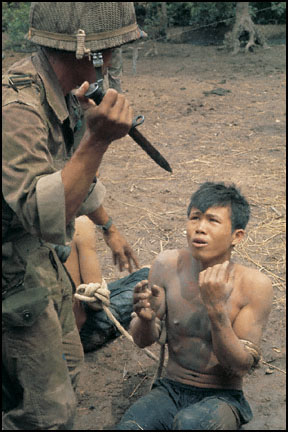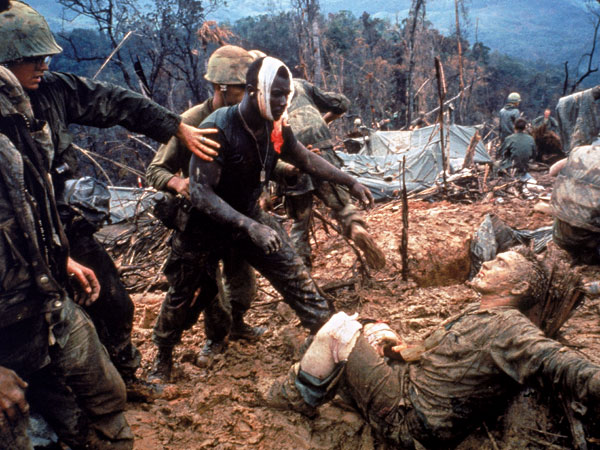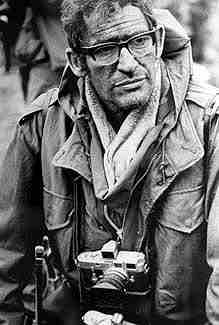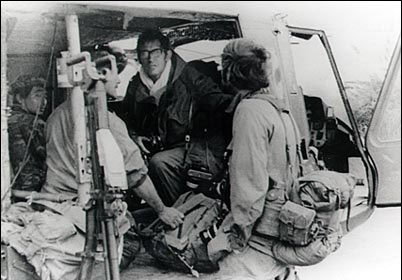
In this essay, I'll be looking at what I feel to be the greatest visual resource for the Vietnam War, and a man whose work I consider great art. First off a introduction by way of dispensing with the rival claims for a representation of the Vietnam War.
The Vietnam in popular culture is like some giant Ouroboros, a snake forever devouring its tail, each interpretation not resting on the source itself but successive interpretations through music, film and video game. First the soundtrack was laid down. Then came the films. Deer Hunter attempted to wash America's sins by portraying a Catholic rite of suffering in the face of evil wilee-Chinee Vietcong sadists. In Cimino's epic - gruelling only in a tedious way - only the first Pennsylvania steel-town bound third rings true. Platoon thankfully achieves more, director Oliver Stone having actually served in Vietnam. It's an action dominated film and it works. But there's a sanity in Platoon, an acknowledgement at all times of the varying degrees of shit they're all mired in.
Full Metal Jacket by contrast is batshit insane, both in the making and in the finished product. A streak of insanity permeates Kubricks vision of Vietnam, or at least the opening third. There's something unsettling behind the amusement of Paris Island in Kubrick's bravura opening. It reveals a little too much of how Kubrick sees a regimented, orderly world with an insane leer at its centre. He unfortunately proves unable to follow this up with the actual trip itself. Kubrick realises he cannot begin to understand Vietnam itself and so settles for a decent, unexceptional second half. Worse is to come. Good Morning Vietnam shits out a series of cheap moments with Robin Williams in full rotten ham impresario gusto. Later we find out from the man he portrays that none of it actually happened. Still, the audiences eat it up. The Vietnam film becomes a bandaid. All attempts to understand are thrown out and instead a checklist is provided of iconic songs, visuals and keynote scenes and the end result is a sort of 'Rock 'n' Roll Years' montage. Hollywood becomes the sin-eater for America and beats itself up over Nam so the audience don't have to. It's Regan's Good Morning in America and as the films roll out a collective sigh of relief is breathed. Phew. We can stop fretting about that now. Such is the feel-good vibe retrospectively washing over the period (hey, we were all heroes - protestors and marines alike!) that Springsteen can release a song damning Regan's America and the endemic unemployment returning disturbed veterans suffer and be mistaken as a flag-waving jingoist by both sides.
The worst was to come in the utter awfulness that was Forest Gump, without doubt the most contemptible film to receive the Academy Award. I mean, at least Crash was merely witless. And at least Cimino gave us Walken and Cazale and had a shit time. Vietnam, consigned to... aw, fuck that. I'm not even going to talk about Forest Gump. I mean, it's just fucking awful. C'mon, you remember. Bubba and his boat. Hey, remember - he can run! He ran from bullies and now he's running from Charlie! Ooh, cute peacenik girl betrays America and gets da aids. Jesus Christ. Crock of shit.
Oddly it's to Tom Cruise that goes the award of most resolutely non-iconic Vietnam moment. In the battle scene in Fourth of July Cruise - playing Ron Kovics - shows himself to completely lose his head in battle, fire off his rifle in full auto and quickly get shot repeatedly without hitting one single Vietcong soldier. A helicopter crashes out of sight behind a hut. A black marine plucks Kovics up and runs with him back to a helicopter - and yet even this is shot completely stripped of any visual flare. You just hear lots of panting and swearing and jiggery, sea-sick and blurred horizon tilting crazily as long grass whips around pounding feet. Everyone swears continually. You don't even find out who won the battle. Marvelous.
Intriguingly, for a vision of all this capsulised you can compare Altman's film M*A*S*H with the network TV version starring Alan Alda. The TV version actually on the whole isn't bad, if you remove the appalling and frankly offensive laugh track forced upon it by CBS. Altman may have disowned it, but it has its moments. It's also intriguing because it's clearly about Vietnam, despite being set in Korea. Starting off going out and out for laughs a more sombre note eventually crept in, and serious episodes occasionally popped up. It's strange that what began as a distraction for viewers from the Vietnam war, a sort of make-believe oasis of comedy, as the agonising final years unfolded, inevitably became a kind of examination of the war itself. It presaged what was to come in the series of films. Ironically, the cast found itself in the same position as the drafted soldier. By series 9 everyone involved wanted to pack their bags and leave, exhausted by nine years of mobile army surgical hospital laughs. CBS however found itself greatly unwilling to kill the most watched show in America and forced everyone to sign up for another two tours of duty.
And now we're in the new stage where Vietnam appears in computer games. Curiously, whilst manna from heaven for songwriters (take a bow Marah) and film-makers, Vietnam proves to be something of a quagmire for game designers. Like the marine at the time, when playing a Vietnam level you can't help but wish you were somewhere else. Perhaps its because we've seen it all before since the game designers seem intent on mirroring every single scene from Platoon and Apocalypse Now. When they don't, they all too accurately recreate the 'war is 90% boredom' of the jungle patrol. Only in multiplayer does Vietnam seem to shine, with Battlefield: Vietnam getting it right by shamelessly glorying in the best beats. Essentially - it's multiplayer, and you get to use flamethrowers and fly helicopters blasting Wagner. What does it teach us? Nothing. Except that war is more fun played with a controler. As it should be. ("I agree," - UAV pilot.)
Vietnam has been now superceded by Iraq, proving that a lesson ultimately failed to be learnt. This lesson isn't 'don't get involved in land wars in small countries', but is the military maxim of 'know your enemy'. It's the failure to acknowledge this simple precept that has caused America so much trouble. As ever for this technologically advanced and gung-ho superpower, fatal optimists have dictated policy. Probably the most fitting film on Vietnam is Errol Morris's The Fog of War: Eleven Lessons from the Life of Robert S. McNamara. In it McNamara essentially apologies for the grievous errors he committed. Priding himself on logic, McNamara ultimately had to face the fact that all his number-crunching decisions created a nightmare insanity in the shadow of carpet bombings and combat sweeps. Iraq is not mentioned, and does not have to be. It is clear to whom McNamara is addressing his findings.
So where do we turn for the truest experience of Vietnam? Well, Kubrick gives us a tip. He writes his principal lead, Joker, as a combat photographer. Outside of the great works of literature on Vietnam, such as Mark Baker's 'NAM' and Robert Sheerhan's 'A Bright Shining Lie' by Neil Sheehan, the best representation exists in the photography of such greats as Don McCullin and Larry Burrows. It's Larry Burrows's work that has hit me hardest when reading about Vietnam, and the man who I personally feel has captured it the best.
After such a lengthy preamble, lets get down to brass tacks. And let's keep it simple, we're dealing with Vietnam here. Larry Burrows was born in London in 1926, left school at the age of 16 and got a job as a darkroom assistant at Life Magazine. In some accounts Burrows has been fingered as the notorious dark room assistant who created what can entirely reasonably be described the single greatest artistic fuck-up in the history of the universe: accidently melting the prints Robert Capra took on Omaha Beach during the D-Day landings. Fortunately, it wasn't actually him, though one could be forgiven for being mistake by the sheer driven nature Burrows subsequently showed in heading out into the combat zone during Vietnam. Burrows was one of the first photographers in Vietnam, arriving with the early waves of 'advisors' from America. In the beginning Vietnam was seen as a poor man's war, a feeble shadow of the great struggle of WWII, even a shadow of Korea. For those involved, photographer and advisor alike, the joke was, "Don't knock the war in Vietnam. It may not be much, but it's the only war we've got."
Burrows wasn't only a photographer, he was a genius. The military in Vietnam allowed him liberties it allowed no one else, both then and since. Burrows persuaded air-crew to take off the doors of planes so he could strap himself in and lean out. He was allowed out in helicopters during combat missions. He was allowed to take and send home photographs no general would allow an embedded photographer in Iraq or Afghanistan. The reason behind this is a curious one. Simply put, the Generals and officers and men of the US Army and USAAF in Vietnam saw his photographs as works of art. And they were. When other reporters complained, they were told by the authorities, "Mr. Burrows's request was granted not because he is a photographer but because he is an artist."
His early photographers are shot in beautiful colour. Moving with the ARVN they show a war before the marines arrive. They pack the same uniforms and guns imported from the US, but there are differences to the Vietnam of popular memory. Firstly the helicopters are of an earlier type. They look like huge sinister locusts, more suitable for hopping than flying. Then there are the expressions. There is a gusto in many of the faces of the soldiers. They lay out dead bodies for inspection. They grin. In two haunting photographs cowering prisoners are threatened with gun and bayonet. It's a cruelty that is only bred in civil war. Despite the atrocities that the Americans would later commit in village burnings and the 'scraggings', there was a shrugged-shoulder fatalism and weariness there, what hate there was an impersonal hate tempered by racism. This is the AVRN during the period where, perhaps for a while, they believed they were on the winning side with the great metal beasts America obligingly delivered. The scenery is more open also, mainly featuring paddies and deltas, or footage from helicopter doorways. Burrows, like America and Kurtz and Marlowe, had not yet waded deeper into the jungle.



The war started out on a shoestring, utilising an odd mix of WWII era prop-planes and Phantom jets. It was one that afforded Larry great opportunities for air combat photography. The USAAF were only too willing to oblige, feeling neglected by the lions share of the press dwelling on the ground pounders. Larry's pictures are of neon and tracer and tin and steel and sunsets and firey blossoms and low ridges and riverside villages erupting in dust and smoke from cannon fire. They are horribly beautiful.



The turning point for Larry, the public and for one poor helicopter gunner named James Farley was his Life photo essay 'One Ride with Yankee Papa 13'. Arguably the most famous photo essay of all time, this features a young American boy - a door gunner - and his metamorphosis. We see him before the mission, happy and gung-ho. Larry boards the helicopter with him. The intelligence proves wrong, the LZ is far from lightly defended and two full companies of highly trained Vietcong pour heavy machine gun fire into the landing choppers. One is downed, and the co-pilot and a marine run to extract the wounded crew. They fail, and the co-pilot, a friend of Farley's, is hit. He dies in front of Farley on the way back to base, amidst a pile of spent shell casings. Back at base, Farley breaks down and cries. It's a shocking series of images that brought Vietnam home for the American public like nothing before. In a way, they changed as Farley did - from innocence through to shock and uncomprehending grief. The images have an electricity, a tautness. In viewing them you realise with shock that Larry was running out of the helicopter along with the two men to photograph them trying to get in the downed craft, and back again and into Papa 13. I mean, you're not only witnessing men in combat you're seeing through the eyes of one here. His time outside the doors is spent in three frames. You can imagine an eternity.





That was 1965, the turning point when more troops were ordered to Vietnam and the weekly casualty rates of the Americans began to supercede from time to time the South Vietnamese. To aptly mix a metaphor; the writing was on the wall, but no one could see it for the trees. 1966 and Burrows joins Operation Prairie, an operation that was to last almost six months. This operation included the meatgrinder that was the battle for Hill 484, a hill deemed as strategically important and one that was after high losses was abandoned by nightfall. Burrows once again was in the thick of it. He worked sparingly, shooting few scenes of men at rest, preferring to wait for the inevitable combat. During the entire September long battle he exposed only 36 rolls of film.



Looking through this period of Burrows's photography one is struck by the beauty of the colours. You get two of them. Green grass and fatigues and brown mud and skin. The mud churned up by boots and bodies is unctous, cloying, slime. It blends with the clay of the flesh. One marine, laid out bottom right with bandages on his knees looks vacantly into the nowhere as a marine with a headwound is guided past him. He is of the clay, and he looks ready to return to the clay. The images are hauntingly beautiful in the way people move. The guiding arm, the stumbling figure, the reclined man. It's a great canvas, except it is all happening. There's a queasy, naked sensuality about it - and a vulnerability. Shattered tree trunks surround them. Bare arms are covered with little nics and cuts. There's a shot of a man with an arm in a sling, hunkered down by a shattered trunk, trying to force chow into his mouth. his arm is tensed, you can see that he is trying to force it between his teeth. In another shot a man is bandaged around the chest. He has a head-dressing on. His eyes are the most beautiful blue, peaceful, unfocused. Blood pours down the side of his face, flowing down past the lower lid in one long smudged stream - a mix of warpaint and tears. A black man howls in pain, his head almost entirely swaddled in bandages - all except his mouth and nose. A field medic is applying a dressing, he's been hit low. These photos brought the sight of black combat veterans to America's eyes. They would be used by both sides of the debate. By anti-war protestors and Black Panthers and by those desperate to show that all America was in this. From these photographs one thing was true - scenes of the war front would now show white men cradling black and vice versa. So as with aethists, there are no racists under fire in a foxhole. Another similar operation followed in Pegasus.
1969 rolled around and with its foot in the door of the American public war photography began to show the civilian cost. Burrows photographed maimed and dying children amidst shows of dancing girls watched by American officers and their families. He shot not with intent. Burrows wasn't interested in messages, he just wanted to show. One haunting image shows a Vietnamese girl holding a coolie hat above her head, grasping some part of small body-bag swaddled form.


With this image Burrows warned in a Life Magazine caption, "There is a limit to the resillency of spirit of any people, no matter how strong."
Then came the invasion of Cambodia and Laos, as America pursued the enemy to their bases there. On Nixon's orders the 'incursion' began. It brought some results with great stockpiles of weapons secured, but the political cost was disasterous. Images of carpet bombing merged with the feeling of a war never ending. Joe Haldeman summed it all up in his sci-fi masterwork 'The Forever War', when soldiers ship out at the speed of light and fight bloody battles on far flung planets. When they return home hundreds of years have passed and the war is forgotten. But they still have to ship back out and continue the fight for their comrades in that time-flung sector.



Robert Capra said that if you aren't close enough, your photos aren't good enough. Burrows certainly was close enough. Burrows claimed the camera made him invisible to the enemy. In fact, so close to danger was he that other photographers began to wonder if it wasn't so much bravery as his terrible eyesight that allowed him to get so deep in the firing zone without flinching. Burrows certainly had remarkable luck, fellow photographer Richard Pyle wondered whether the Vietcong had been instructed by their high command, "Don't shoot! That's Larry Burrows's out there!" Most journalists played up to a glamorous, hard drinking image. Not so Larry. Once back from the combat zone he first painstakingly cleaned his equipment, then showered and dressed himself in an immaculate suit. Despite his poverty stricken background (he spent his youth down the pit) he liked to dress smart. He'd present himself at the bar and chat. There was no auteur pose from Larry. He offered advice freely and was still keen to learn. He casually deflected the awe newcomers projected upon him and replied to American questions with trademark British understatement. A fierce firefight was described as being 'a bit dicey'. One young American reporter asked him what one particularily bloody battle had been like, to which Larry replied, "Quite lively in a way." He paused. "You might want to be a little bit careful."

Sadly, Larry's luck couldn't last forever. Three months short of his forty-fifth birthday he was shot down somewhere near the Laos border, along with three other photographers, one of whom was the equally accomplished Vietnamese photographer Henri Huet. His body was never found, though his camera, a crushed Leica, was. This was the last image of Larry, before taking off:

Burrows wasn't the only photographer in Vietnam of course. Henri Huet has an equal claim to greatness, and other brilliant work is there by Nick Ut, Catherine Leroy, Sean Flynn, Gustav Cibrushsille and Robert Hodierne. Curiously however it took outsiders in the shape of British photographers to capture the American side of the war best - the great trio being Larry Burrows, Don McCullin and the Welshman Phillip Jones Griffiths. It is their images that render Hollywood's offerings largely redundant.
The Vietnam period work of Larry Burrows is collected in the superb 'Larry Burrows: Vietnam' published by Jonthan Cape. The images posted above do not do any justice to the single and double page spreads within this hardbook book. You owe it to yourselves to get this. There's a superb introduction by David Halberstam. Each period has a concise introduction. I have shamelessly cribbed quotes and information from these. If you give a damn about great photography, get this.
http://www.amazon.co.uk/Vietnam-Larry-B ... 077&sr=8-2(Warning, Grim... levels of finance required.)Thanks for reading. I now open to the floor for thoughts on war photography, Vietnam related computer games, movies, tunes and what-not.

